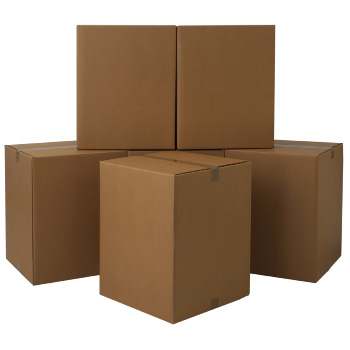Freight from the USA
|
|
|
|||
However, in sea freight, rates are typically calculated by volume (cubic meters or feet) rather than weight. This is because cargo ships have limited space capacity, but are not limited by the weight of the load.
Unlike air or road transport, ocean freight typically charges for the space your cargo occupies, rather than its weight. This means two shipments of the same size will cost the same, even if one is much heavier.
The international shipping costs are calculated per cubic meter (or cubic feet), making pricing predictable and straightforward. Whether your goods weigh 100 kg or 500 kg, the price depends only on their volume. This approach helps budget global logistics accurately and avoids surprises from weight-based fees when shipping goods from the USA to international destinations.
A cubic meter of goods means a relatively large load.
For example, delivering overseas of one cubic meter (CBM, M³) is equivalent to international delivery of 12 standard U.S. medium boxes measuring 18"x18"x16" each.
Our online freight calculator estimates volume in cubic meters, as international shipping costs in global cargo transportation are calculated using the metric system. It simplifies global logistics for LCL intl shipments. This web page explains the meaning of cubic meters in LCL freight from the USA to worldwide destinations.
What is the CUBIC METER?
This image and the short video on YouTube should help you determine the size of a cubic meter.
Technically, a M³ can be any combination of dimensions, provided that all three dimensions (in metric meters, including the decimals) are multiplied by each other, resulting in 1.
LCL stands for Less-than-Container-Load. It is the most convenient and economical way to ship relatively large loads overseas. Another advantage is that with LCL, cargo self-delivered to sea carrier terminals (CFS), weight is usually not a pricing factor*.
*This statement is invalid if you carry extremely heavy loads and the density of transporting goods exceeds a density limit in your particular shipment. Regular commodities will unlikely exceed the density limit.
In other words, unlike with parcel services or air freight, LCL prices are primarily based on the size of cargo, not its weight. LCL price quotes are based on ocean freight rates per M³ (or ft³), but not the poundage in kilos or pounds. As soon as the shipment is delivered to an ocean carrier's terminal (CFS, Container Freight Station), shippers should no longer worry about the weight of the shipment. Just disregard the weight.
If you pack your goods in standard moving boxes to ship internationally from the United States, these pictures should give you an idea of how boxes may fit into the size of one M³.



Note that the overall volume of your boxes does not have to be limited by one CBM. International shipping with LCL is not limited to one M³. The total volume will be derived as the sum of the volumes of all your boxes (including fractions). For example:

Transporting overseas 20 loose boxes, sizes 18"x14"x12", equals the shipping of 1.42 M³. (20x1.50'x1.67'x1' = 50.1 ft³ = 1.42 M³)

Transporting overseas 6 boxes, sizes of 18"x18"x22", is equal to shipping of 0.7 M³* (6x1.50'x1.50'x1.83' = 24.7 ft³ = 0.7 M³)
*IMPORTANT: LCL freight rates always include minimum charges for the entire intl shipment.** In this example, if the rate is $125 per CBM with a minimum charge of $125, you always pay $125, even if the size is less than one cubic meter.
Typically (but not always), minimum charges equal the costs of carrying a load of one CBM (or 35 ft³). For example, if your overall volume, multiplied by the LCL freight rate per CBM, is less than the minimum, you will be charged the minimum amount, regardless of the actual volume you ship.
You can ship items of any size, including boxes, crates, luggage, or any other adequately packed items for overseas conveyance. The only limit is that all your internationally shipping units should fit into a 40-foot multimodal sea container.
Accurate CBM calculations have a direct impact on international shipping costs and overall pricing. A licensed U.S. freight forwarder should assist with accurate CBM calculations and booking space. Consult your freight forwarder to schedule an intl shipment.
W/m is the acronym for weight or measurement commonly used in international and U.S. domestic cargo transportation. It means weight or measurement, whichever is greater. The W/m rule presents a cargo density limit. Global freight rates for regular commodities are calculated based on size, while rates for heavy items are recalculated considering the weight. W/m calculations differ depending on the mode of transportation and the carrier.
Shippers should be aware of the chargeable weight and volume (w/m) standards applicable to different cargo transportation modes. Regarding global cargo transportation from the USA utilizing Less-than-Container-Load, there are two modes: international freight and U.S. domestic LTL ground conveyance.
International freight: Since vessels' capacity is not limited by tonnage but by the size of their holds, rates for regular commodities are usually based on the size, not the heaviness. If shipment is self-delivered at an ocean carrier terminal (CFS), you may disregard the weight of your goods. Prices from CFSs will be calculated per CBM or ft³.
Remember that a density limit applies when transporting weighty items. It is called "w/m - weight or measurements, whichever is greater." The limit varies depending on the sizes of vessels, ocean carriers, origins, destination regulations, and other factors. Regarding the transportation of goods from the U.S. by sea, the w/m may occur when transporting to the Caribbean and Mexico.
Regular commodities are unlikely to exceed the density limit. When shipping goods from the USA overseas LCL, it's essential to know the "U.S. 45 lbs Rule: 45 lbs = one cubic foot." Suppose the density exceeds 45 lbs per cubic foot. In that case, the chargeable volume (total price of such a shipment) will be calculated using this formula: Total weight of load in pounds divided by 45 lbs = chargeable volume in cubic feet.
A similar limit is in metric calculations: the "1 M³ = 1000 kilos rule" can also be used. It is called a "metric ton." However, depending on a vessel, ocean carrier, etc., the w/m limit may vary: one cbm = 750 kilos; 1 M³ = 500 kilos, etc. When transporting weighty items, consider the weight/mass limit when quoting and booking such shipments. In other words, if exporting a weighty load, pay attention to the w/m limit.
U.S. domestic LTL ground transportation: Regarding shipping internationally using LCL, this applies to inland cargo conveyance within the USA from the location to an ocean carrier's terminal (CFS), particularly on pickup or line haul. In U.S. domestic conveyance, prices are calculated by the mass in kilograms or pounds and should be separated from sea freight charges on invoices.
In international conveyance with Less-than-Container-Load, the U.S. domestic part of the transportation is typically supported by U.S. LTL carriers. LTL means Less than Truck Load. Please do not confuse it with LCL.
W/m in LTL (inland transportation within the USA) is more regulated than in Less-than-Container-Load. All LTL shipments are subject to actual or dimensional weight verification. Typically, in the USA, in LTL, chargeable weight is calculated using this formula:
Chargeable (Dimensional) Mass in Pounds = Actual Mass OR (Length x Width x height in inches) divided by 194, whichever is greater.
The cost and dimensional weight of U.S. LTL conveyances also depend on the freight class, which depends on the kind of goods.
Regarding international cargo transportation using the FCL service, FCL (Full Container Load) prices are primarily based on the size of ocean containers, rather than the weight or dimensions of the goods. International shippers should pay attention to the capacities of multimodal sea containers.

Here are capacities and payloads for the most commonly used multimodal sea containers:
*Payload should not exceed legal over-the-road limits in the United States and Canada. The recommended maximum payload for containers transported within the USA and Canada is 35,000 lbs per 20' and 42,000 lbs per 40' sea container.
Your freight forwarder ensures compliance with the limits when booking a container for global logistics.
Prices with carriers that provide RO-RO service are based on the sizes of vehicles in CBM or ft³ and the type of vehicles being shipped. The larger a vehicle is, the higher the price per cubic meter (CBM) or cubic foot (ft³).
In RO-RO, the total international shipping cost is calculated by multiplying the vehicle's overall size in CBM or ft³ by an ocean freight rate per CBM or ft³.

Exemptions can be Ro-Ro rates for cars. For cars, the fee is a lump sum per vehicle, depending on the vehicle's size. For example, the price for shipping cars with an overall size of up to 600 ft³ and a height of up to 1.6 meters from the U.S. to a particular country is a lump sum of $1,300 plus BAF and CAF, etc. However, you may notice that the "lump sum" for transporting a car is also related to a range in sizes in CBM or ft³.
|
|